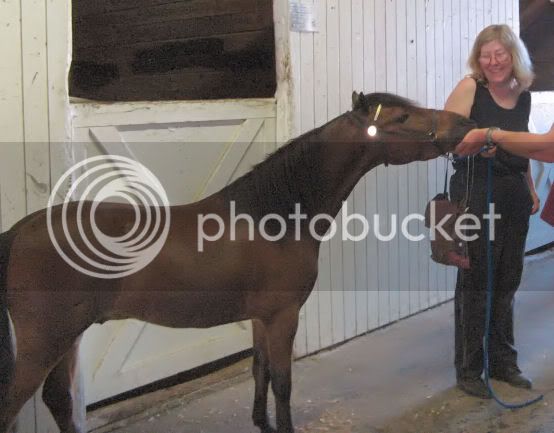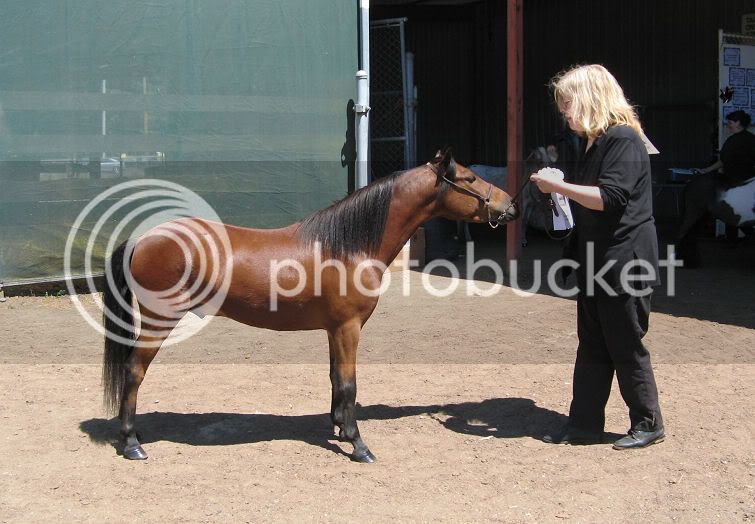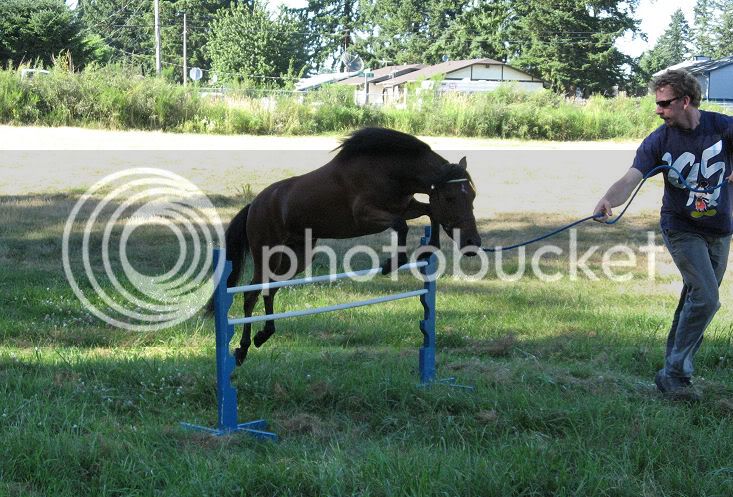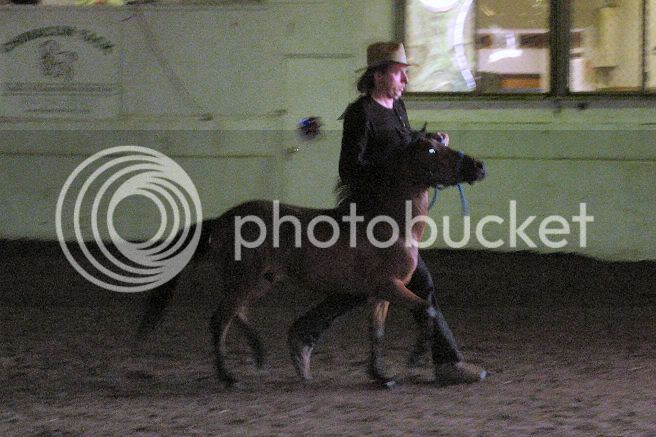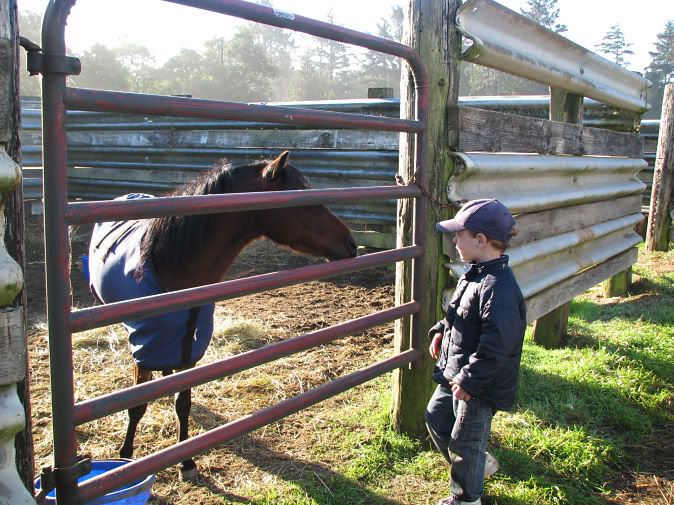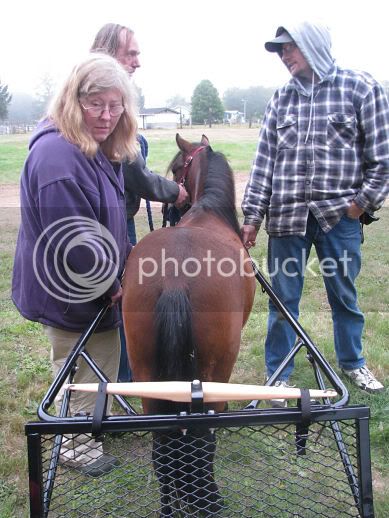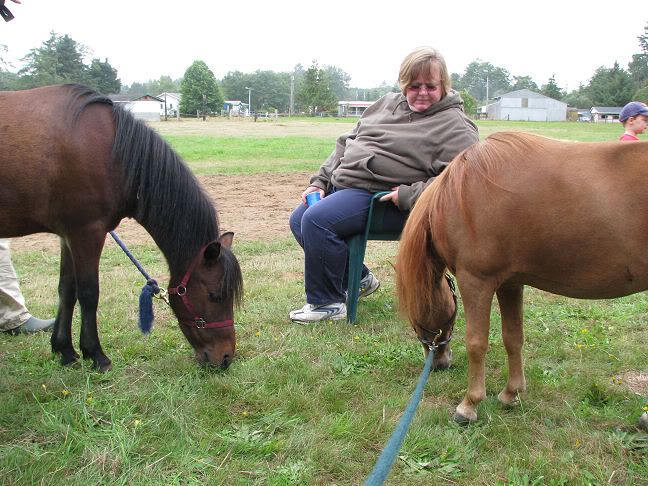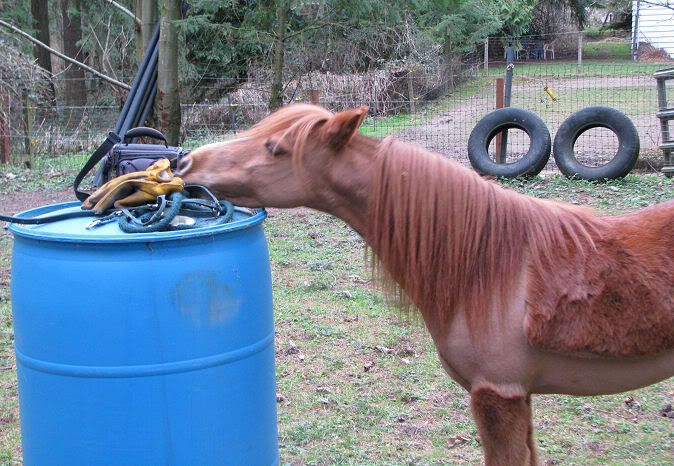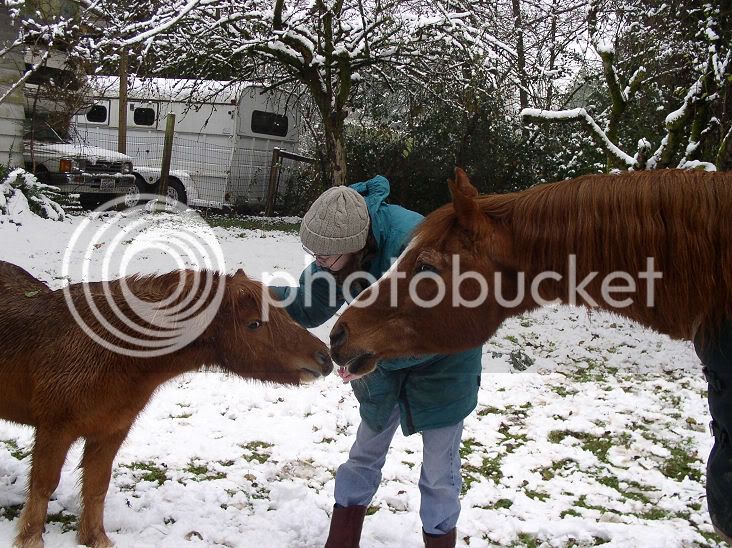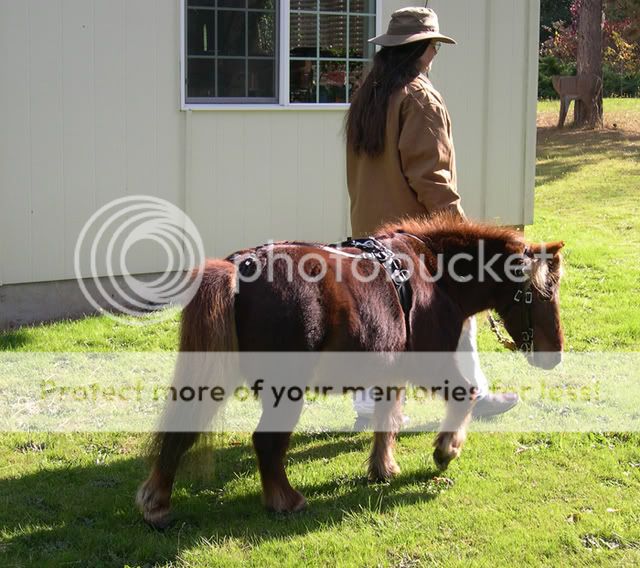MiLo Minis
Well-Known Member
[SIZE=12pt]Hi Lori, glad you've replied.  I hope you don't mind if I pick your brain.
I hope you don't mind if I pick your brain.
 [/SIZE]
[/SIZE]
That's one reason that I've avoided fixed side reins, is that their fixed and really even with elastic they don't move. But my Mom has used them with her horses, I think she likes them.
And I don't rule them out completely, I just haven't used them yet. When you lunge with sliding side reins do you keep them the same length? or switch them with the inside one a little tighter?
The whole point of sliding side reins is that they slide
 I use a piece of nylon rope as it slips nicely through the rings. I tie it to one ring on the side of the surcingle (I usually start fairly low to begin with and work my way up as the horse improves) then through the bit on one side, down between his front legs to a ring on the girth, up to the bit on the other side and tie it to the other side of the surcingle. This allows the whole thing to slide through no matter where the horse has his head. I start by making sure they are even but as he works himself on a circle he will gradually shorten the inside rein as he bends around the circle. When he changes direction the rein will slide through and again shorten on the inside on its own basically. They need to be adjusted loose enough that they can slide but firm enough to start that they will do the job of showing him what you want. Once he gets the hang of it you can loosen them further.
I use a piece of nylon rope as it slips nicely through the rings. I tie it to one ring on the side of the surcingle (I usually start fairly low to begin with and work my way up as the horse improves) then through the bit on one side, down between his front legs to a ring on the girth, up to the bit on the other side and tie it to the other side of the surcingle. This allows the whole thing to slide through no matter where the horse has his head. I start by making sure they are even but as he works himself on a circle he will gradually shorten the inside rein as he bends around the circle. When he changes direction the rein will slide through and again shorten on the inside on its own basically. They need to be adjusted loose enough that they can slide but firm enough to start that they will do the job of showing him what you want. Once he gets the hang of it you can loosen them further.
[SIZE=12pt]Could you explain more about what you see in Banner's conformation. I've always felt that he isn't built to work correctly, but I honestly can't pinpoint it. So if you have the time I'd love for you to explain more.
 [/SIZE]
[/SIZE]
He does drop his head and work very nicely sometimes, but I have yet to get a picture of it. (of course
 )
)
And thank you for all your other suggestions, these are all points that I am working on and keep in my head while driving. He actually moves quite straight when driving, and he seems to work best when we are actually doing something driving, like weaving through a dozen trees we have on the property and doing transitions through them. Stuff that makes him think there is actually a reason for all my madness.
He actually moves quite straight when driving, and he seems to work best when we are actually doing something driving, like weaving through a dozen trees we have on the property and doing transitions through them. Stuff that makes him think there is actually a reason for all my madness.
 But I do try to kind of vary it up to give both of us a break.
But I do try to kind of vary it up to give both of us a break.
First let me tell you that my favorite driving horse has some of the same conformational flaws that Banner exhibits so I in no way saying I don't like your boy
 And he certainly has some very good qualities that will make him a wonderful driving horse, the most important one is that he is naturally straighter by far then Mingus and shows a natural tendency to bend correctly. I think he is going to be an athlete. He loses that when you put him in the shafts but it is there and so you know you can bring it out with the right work.
And he certainly has some very good qualities that will make him a wonderful driving horse, the most important one is that he is naturally straighter by far then Mingus and shows a natural tendency to bend correctly. I think he is going to be an athlete. He loses that when you put him in the shafts but it is there and so you know you can bring it out with the right work.
Anyway here goes: His head is a bit on the large size which is quite typical of many Minis. He has quite a ewed neck (and this is his biggest fault that he has to overcome for driving) which ties in a bit low. His throatlatch is a bit on the thick side, his neck is not a great deal slimmer at the throatlatch than it is at his shoulder. All of this makes it a bit more difficult for him to get his head down where we want it to start and he will never be able to use it as well as a horse with better construction could. He has a dip both in front of the withers and behind which will make it a bit more difficult for him to use his back. He has a steep shoulder but the good thing is that he also has a steep croup to match which will help prevent stress injuries that would occur if the angles weren't matching. That steep croup will allow him to get his back end under himself a little easier but combined with his somewhat weak stifle and hock construction you are going to need to be careful not to overstress his joints. All that being said I do see good potential in this horse, he is just going to need more careful conditioning than some.
That's one reason that I've avoided fixed side reins, is that their fixed and really even with elastic they don't move. But my Mom has used them with her horses, I think she likes them.
And I don't rule them out completely, I just haven't used them yet. When you lunge with sliding side reins do you keep them the same length? or switch them with the inside one a little tighter?
The whole point of sliding side reins is that they slide
[SIZE=12pt]Could you explain more about what you see in Banner's conformation. I've always felt that he isn't built to work correctly, but I honestly can't pinpoint it. So if you have the time I'd love for you to explain more.
He does drop his head and work very nicely sometimes, but I have yet to get a picture of it. (of course
And thank you for all your other suggestions, these are all points that I am working on and keep in my head while driving.
First let me tell you that my favorite driving horse has some of the same conformational flaws that Banner exhibits so I in no way saying I don't like your boy
Anyway here goes: His head is a bit on the large size which is quite typical of many Minis. He has quite a ewed neck (and this is his biggest fault that he has to overcome for driving) which ties in a bit low. His throatlatch is a bit on the thick side, his neck is not a great deal slimmer at the throatlatch than it is at his shoulder. All of this makes it a bit more difficult for him to get his head down where we want it to start and he will never be able to use it as well as a horse with better construction could. He has a dip both in front of the withers and behind which will make it a bit more difficult for him to use his back. He has a steep shoulder but the good thing is that he also has a steep croup to match which will help prevent stress injuries that would occur if the angles weren't matching. That steep croup will allow him to get his back end under himself a little easier but combined with his somewhat weak stifle and hock construction you are going to need to be careful not to overstress his joints. All that being said I do see good potential in this horse, he is just going to need more careful conditioning than some.
That has been what I have seen with the use of fixed side reins. Horses get stiff through the jaw and neck with excessive use of them. Yes his head might be in the right position but you don't get that free flow of energy and rounding through the back because there is tenseness there. If I am having trouble with a horse figuring out the sliding reins I will put them on, as I said, a bit overtight and more so on the inside to basically overflex his neck and turn him loose in the round pen for a short period of time - first on one side, then the other. I find then that when I go back to work with the sliding side reins they give to the soft massaging feel a lot quicker. I use them strictly as a teaching tool when needed. I do use a full cheek with them on to prevent the bit pulling through.[SIZE=12pt]I'm thinking maybe this would help my boy... I'm sure doing this would create quite a reaction.[/SIZE]
NEVER put any auxilliary piece of equipment on a horse without allowing him to check it out on his own loose in the round pen first. This includes blinders, breeching and any sort of extra rein. Some back haphazardly, some rear, buck or kick, some run madly. Turn him loose and let him get the kinks worked out with you out of the way. Once he is comfortable with it then you can go in and work with him and then take them to the cart with you. I really don't think your boy needs a fixed side rein, he bends too nicely on his own.
I do think he would benefit from sliding side reins as I can see from your loose contact in all your photos that you really are afraid of taking contact with this horse. He NEEDS that support from your hands which, until you are more educated with your hands, the sliding side reins will help provide but you do need to take up your contact even when using them. The reins should come straight from his mouth to your hands - not taut so that you could strum a tune on them but slightly elasticy and giving, they should kind of just wave up and down slightly over the length of them with his movement. You will need to be careful to follow his head down when he offers to do so keeping the same contact all the way through.
I'm not a big contraption user, although I have never used sliding side reins. We used to use side reins, but I have found that the Three H's tend to work better for me, Hills & Half Halts. Hill work really gets them to use their butt and drop their head. Just as I have said before, they figure out that it is easier to use their rear ends to push the cart. The other nice thing about hill work, is that you don't have to have any special training to do it, and it is pretty hard to screw up if you are a novice at training horses (unless you try to drive along a side hill and roll your vehicle).
I just don't feel it is fair to take a horse that doesn't know how to pull properly up and down a lot of hills. They won't have built up the muscles necessary to push that cart up or hold it back when going down. Not only do you risk a stress injury to a green horse by working him on hills but you also risk frightening him causing an accident. That's just my opinion and if it works for you more power to you but it isn't something I personally would consider until my horse had learned the basics of self carriage.
Another technique that will get them to use their haunches and accept bit contact better is bending and turning in obstacle work. Set up some cones or filled milk jugs or whatever about 6-8 ft. apart, and start driving through them. Again, it is pretty hard to screw up, just make your bends wide at first. Don't ask for tight turns. It also helps to "stay on the same rein", meaning when you make turns, don't go right and then left and then right. Make all your turns one direction, first. Eventually, make your turns smaller when your horse seems to "get it".
Again this is not something that I would consider doing until my horse had learned the basics of self carriage. Cones 6 to 8 feet apart are going to require a far tighter turn than I want to use when teaching a horse to relax and drop his head. Turns this tight are going to frighten and tense up a green horse which will cause him to lift his head and hollow his back. I would save these kinds of exercises for when my horse was confidant in his balance and I wanted to start working on really rocking him back on his haunches. I always start - without cones or anything that might make him leery appearing in and out of his blinders - doing serpentines and spirals, lots of gait changes, gradually tighter circles and deeper corners.
With obstacle work, horses also seem to appreciate the opportunity to "see something different" other than going round and round on a longe line. You are asking for bending in the process, but it also gives YOU a "target". The process of bending will get them to place their inside hind foot underneath themselves (or they fall over), and when they feel secure in their balance, their heads naturally come down. Most horses don't WANT to go around with their heads in the air, they just haven't figured out how to put it down and not fall over! IMO, heads have to come down in the training process before they can come back up and in for the "show frame". In my experience, using a contraption to accomplish this is a "force" that the horse has to learn to deal with instead of figuring out on his own how to balance himself. This process may take a little longer, but then you don't have deal with the compounded problem of adding tension in the training process that has to be gotten rid of.
I don't take the tension into the training process by allowing the horse to play on his own in the round pen till he is comfortable with the equipment.
I have found that some horses, that have been travelling around all their life with their nose in the air, naturally crooked (as most, if not all, are) and moving comfortably on their forehand and are quite happy moving that way, need that extra encouragement to be able to "get" that there are other ways to move when we add the weight of the cart and throw their natural balance out the window.
I find that when I ask a horse to do tight turns and actual corners before he has found his balance in the cart that adds a great deal more stress and tension than any "contraption" I choose to use. Again, this is my personal experience and opinion.
Here's a thought, for those that use sliding sidereins. The ones I have made are extremely lightweight. I like the look of the ones Leia has shown because they are still in effect even if they were looser then needed. With the ones I have they have to be quite snug or he can't feel it. Just wondering if 1. this makes any sense; and 2. if anyone thinks that could be one of the things not clicking right now.[/color][/size][/font]
Even when adjusted fairly loose the sliding side reins will still gently massage the horse's mouth and have some effect (think of the western pleasure horse and how loose their reins are) but you do need to start with them more tightly adjusted. Once your horse is working well they will just be hanging there and not really having any affect. Mine are made of 1/4" nylon rope which is VERY light and they work just fine.
Last edited by a moderator:




